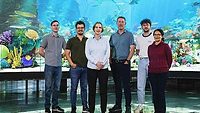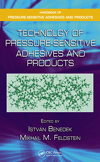Snorkeling with Dragons and Adhesives Helping Reef Restoration

This issue of ASI is devoted to the formulation of adhesives and sealants and the raw materials used in that process. It also discusses technology for mixing adhesives, and some end-use products. So, to kick off this issue, let me tell you about one of the happiest days of my husband’s life and how adhesives are helping to ensure other people will also have similar days.
The location was the Indian Ocean, off of Rinca Island – the island of Komodo dragons, but on the non-Komodo-dragon side of the island. We were there to snorkel in a newly created national park set aside for the reefs around the island, the sea life, and also, of course, dragons. The moment my husband, brightly identifiable in an orange shirt, walked into the water, he was completely immersed in the joy of that experience. Sure, he would bob up occasionally to see how I was doing, but realistically for him, there was nothing during those days but the reef and the fish.
My experience, on the other hand, began with utter terror. Half a world away, clutching my daughter’s hand, she said, “Put your face in, look down, mom.” There, I saw a world of fish and coral more exquisite than any aquarium, any Jacque Cousteau documentary, even anything Pixar animators capture in stories about Dory and Nemo! Oceans are vast, they can be terrifying, but within them is a world of such beauty and mystery that writing about that experience years after still takes my breath away. It changed my relationship with oceans. I think about them often, and I worry about the wellbeing of the creatures who depend on coral reefs. I never thought this job editing a B2B publication about adhesives and sealants would involve coral reefs and the work to preserve them. But here we are!
Researchers at Queensland University of Technology (QUT) in Brisbane, Australia, are developing an underwater adhesive gel and are exploring ways of using it to repair and accelerate the natural stabilization of coral reefs, including the Great Barrier Reef. Inspired by nature, the adhesive is biocompatible and biodegradable, attributes essential for use in this extremely delicate environment. The adhesive is also scalable, making it viable for large-scale reef restoration projects.
Researchers are hoping to use the adhesive to attach young corals onto cement tiles, which in turn are slotted onto a ceramic coral deployment device in reef re-seeding efforts. The tiles with the young corals would then be distributed to reefs in need of re-seeding. Once the coral has had time to grow over the ceramic device, it will naturally break down, leaving little to no impact on the ecosystem. QUT researchers are currently conducting laboratory tests with the adhesive in this environment and are planning a small-scale reef trial.
Additionally, other researchers are exploring the use of the adhesive for repair of reefs after damaging events, such as cyclones, ship groundings, or dynamite fishing. In this application, the gel-like material will be used as a type of structural adhesive that can secure loose coral on the sea floor so that new corals can attach and regrow. In the normal course, this stabilization is accomplished by marine organisms that naturally bind and stabilize the coral rubble. The adhesive mimics this binding process, speeding up the stabilization and eventual restoration of the damaged reef.
The research done in this industry consistently amazes me, and I enjoy sharing it with you. If you want to stay up-to-date on the latest research within academia and industry, make sure you register on ASI’s website and visit often. Also, subscribe to our eNewsletters, where information such as the one described in this editorial are delivered to your inbox. ASI’s associate editor, Marlowe Coolican, and I are committed to making sure ASI is the go-to source for the latest in research and development within adhesives and sealants.
Check out this issue of ASI to learn more about the current state of raw materials in ChemQuest’s Raw Materials and Chemicals Overview. Also featured this month is an article by Ingevity about the benefits of caprolactone technology in reactive hot melt adhesives, an article by Trinseo explaining why formulators should consider adding styrene binders to their portfolios, and a description of an H.B. Fuller foam encapsulant that is making EVs safer. Plus, learn who will be speaking at the upcoming ASC Sustainability Summit. Writing the article about the summit made me excited to attend this event. I hope to see you there!
Looking for a reprint of this article?
From high-res PDFs to custom plaques, order your copy today!









